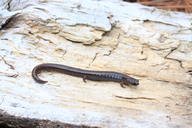|
Thorius narisovalis Taylor, 1940
| family: Plethodontidae subfamily: Hemidactyliinae genus: Thorius |
 © 2015 Sean Michael Rovito (1 of 17) |
|
|
Country distribution from AmphibiaWeb's database: Mexico
Author: Jean Raffaëlli Thorius narisovalis Taylor, 1940 Grande espèce. 3,1 cm SVL (7,1 cm). Forme robuste, narine de petite taille et arrondie. Pas de dents sur les maxillaires. Bande dorsale brun rougeâtre s’étendant sur la queue, contrastant avec les flancs noirâtres, tête noire. Parfois, chez certaines femelles, la bande est absente et le dos noirâtre. Parties ventrales gris brun avec quelques taches crème. Au nord de la ville d’Oaxaca, dans la région de Cerro San Felipe (Sierra d’Aloapaneca, centre nord de l’Oaxaca), la chaîne située immédiatement au sud de la Sierra de Juarez, ainsi qu’au sud de La Tlaxiaco. Entre 2600 et 3 000 m, dans des forêts mixtes pins/chênes et en forêt de brume sous des morceaux d’écorces et de bois à terre. 23 km2. CR. Anciennement commune, devenue extrêmement rare. Présente dans le parc national Benito Juarez. Pseudoeurycea smithi et unguidentis sympatriques. A tendance à s’échapper prestement en sautant (Taylor, 1940).
It is a big species. 3.1cm SVL (7.1cm). It is robust-looking. The nostril is small and round. There are no maxillary teeth. There is a reddish brown dorsal stripe continuing on the tail, contrasting with the black flanks. In some females the stripe is absent and the back is black. Head is black. Ventral parts are grey/brown with a few cream spots. Sympatric with Pseudoeurycea smithi and unguidentis. It tends to escape quickly by jumping (Taylor, 1940). Habitat & Range: North of the city of Oaxaca, in the Cerro San Felipe region (Sierra de Aloapaneca, central north of Oxaca), the mountain range just south of the Sierra de Juarez, as well as south of La Tlaxiaco. It lives between 2600 & 3000m asl in mixed pine/oak forests, and in cloud forests under wood and bark fragments on the ground. 23Km2. Conservation:
Critically endangered. Formerly common, it has become extremely rare. It is present in the
Benito Juarez national park. Feedback or comments about this page.
Citation: AmphibiaWeb. 2025. <https://amphibiaweb.org> University of California, Berkeley, CA, USA. Accessed 2 Jun 2025. AmphibiaWeb's policy on data use. |



 Raffaëlli Account
Raffaëlli Account Map of Life
Map of Life
 ENGLISH TRANSLATION - Julian Wittische
ENGLISH TRANSLATION - Julian Wittische